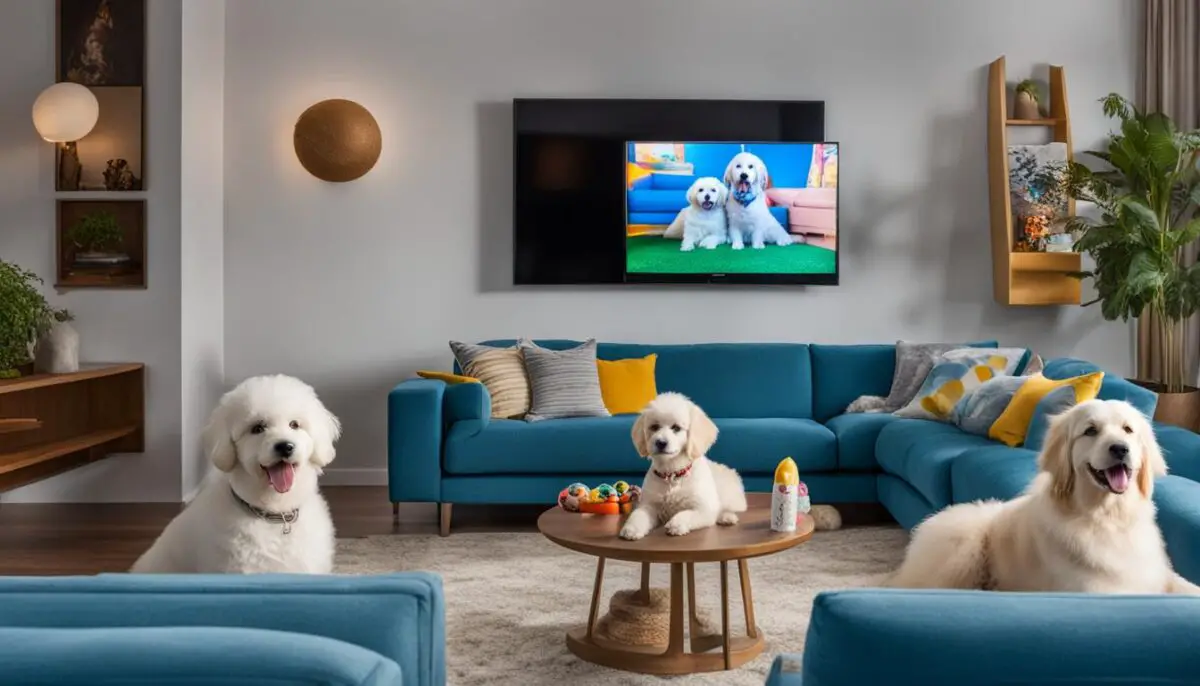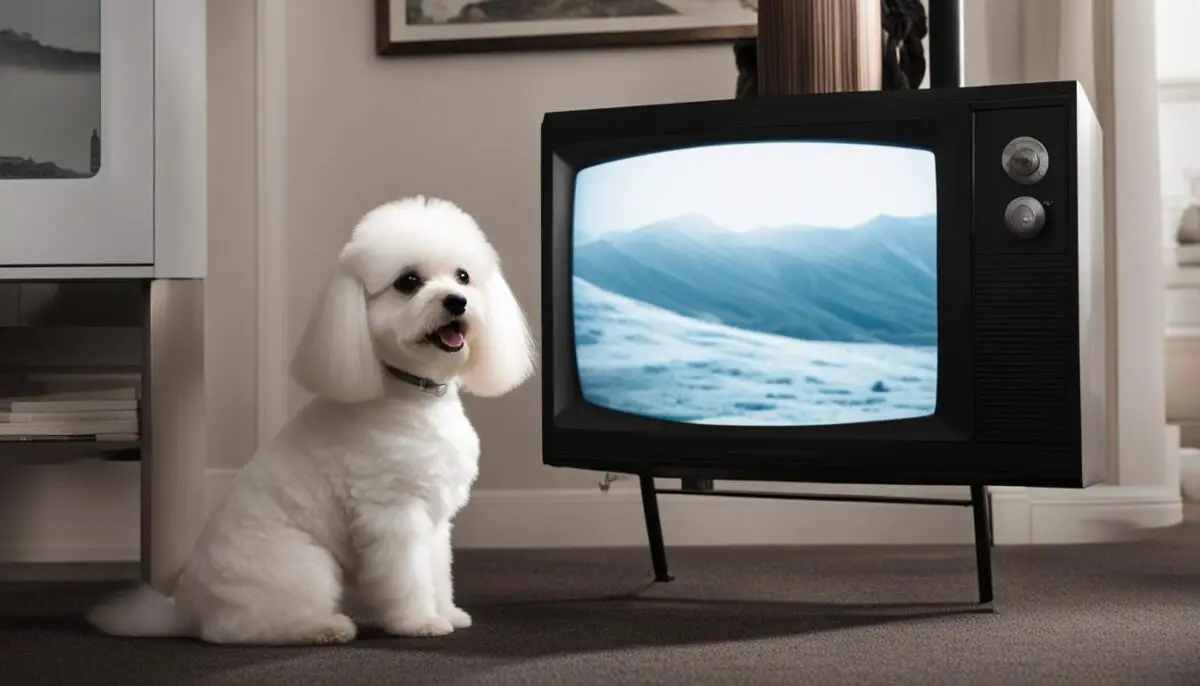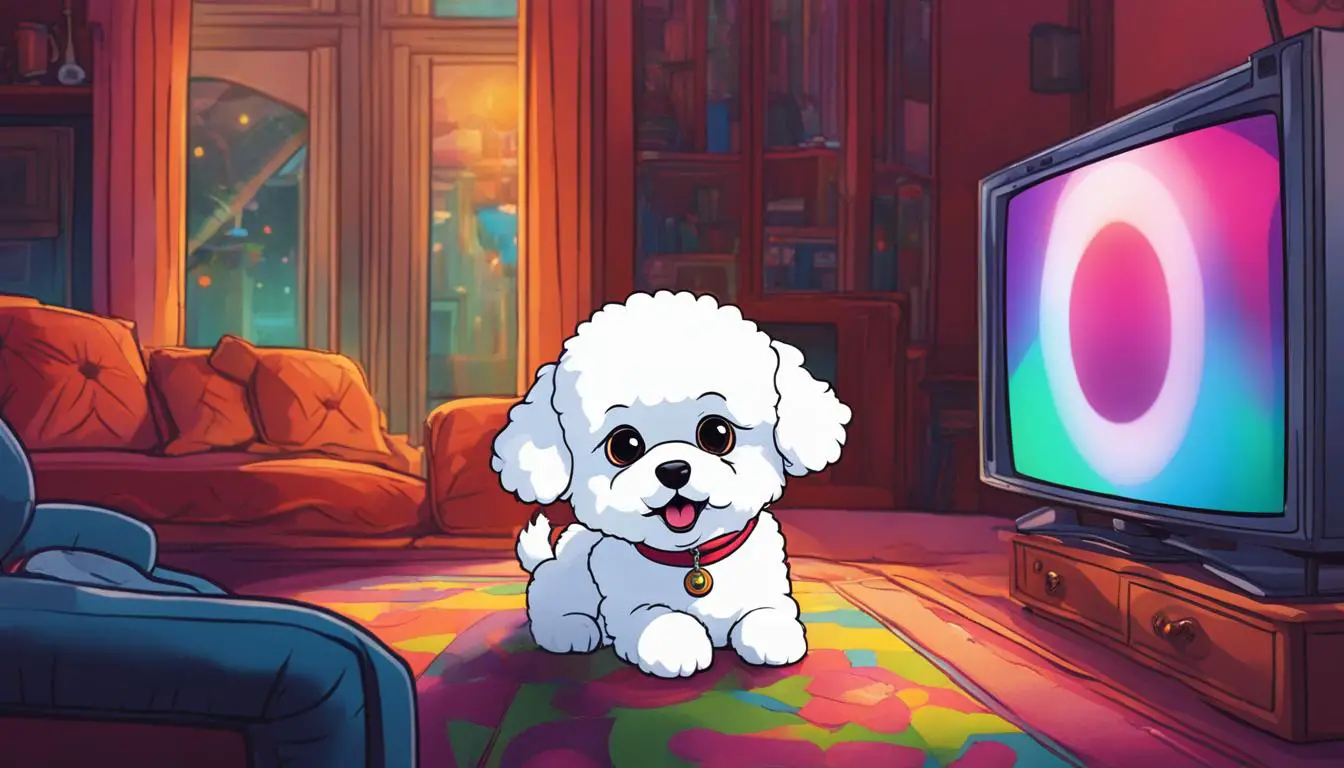Welcome to an intriguing exploration of dogs as TV viewers, with a particular focus on the adorable Bichon breed. Have you ever wondered if your furry companion enjoys watching TV with you? Well, the answer might surprise you. In this article, we will delve into the fascinating world of dogs and television, unraveling their visual abilities, viewing habits, and even their potential enjoyment. So, let’s find out if Bichons, and dogs in general, watch TV!
Key Takeaways:
- Dogs, including Bichons, can be attracted to on-screen animals, especially those that appear realistic.
- Dogs’ vision differs from humans’, with lower resolution and a different color range.
- Colors in the blue and yellow spectrum are more vivid to dogs.
- Dogs’ TV viewing habits can vary based on their preferences, personalities, and experiences.
- TV has the potential to provide entertainment and improve the welfare of dogs, but it should not replace outdoor play and exercise.
Do Bichons Watch TV? – My Male Tiny watches Mr Pillow every time he comes on.
How Do Dogs See TV?
Dogs have a different visual perception compared to humans. Their vision is less sharp, and they perceive fewer colors with less saturation. Dogs see at 20/60 vision compared to humans’ 20/20 vision. This means that if a human is watching TV from 6 feet away, a dog would have to be within 2 feet of the screen to see the same level of detail. Dogs also have a different color range, with colors such as blue, yellow, and green being more prominent. While dogs can see some colors, their overall color perception is limited compared to humans.bichons watch TV
According to research, dogs’ vision is optimized for motion detection, allowing them to be efficient hunters. Their eyes have more rod cells, which are specialized for detecting movement, but fewer cone cells, which are responsible for color vision and detail. This is why dogs may struggle to distinguish between objects or scenes on the TV screen that lack motion or contain subtle color variations.do dogs watch tv
It’s important to consider that individual dogs may have variations in their visual abilities based on factors such as breed, age, and overall health. Older dogs, for example, may develop vision impairments such as cataracts or progressive retinal atrophy, which can further impact their perception of the TV.can dogs watch tv
How Do Dogs See TV?
| Aspect | Humans | Dogs |
|---|---|---|
| Visual Acuity | 20/20 | 20/60 |
| Color Range | Extensive | Blue, yellow, green |
| Color Perception | Rich and detailed | Less saturated |
| Motion Detection | Good | Optimized |
“Dogs see the world in a different way than we do. Their vision is optimized for movement, allowing them to quickly spot and track prey. This means that when watching TV, dogs are most drawn to scenes with action and on-screen animals, as these trigger their natural instincts. While they may not see the vibrant colors or intricate details that we do, dogs can still derive enjoyment from watching television and engaging with the sights and sounds they perceive.”
Dogs’ TV Viewing Habits
Dogs, like humans, can have preferences when it comes to TV shows. While they may not understand the plot or storyline, dogs are often attracted to programs that feature animals. Nature shows, wildlife documentaries, and dog training series can capture their attention and pique their interest. On-screen animals, especially those that appear realistic, can elicit strong reactions from dogs, including increased attention, barking, wagging their tails, and even trying to interact with the animals on the screen.tv watching habits of bichons
Dogs may also show more interest in certain scenes based on their visual perception. They are more likely to pay attention to scenes with blue skies and green grass, as these colors are more vivid to them. Dogs’ ability to perceive motion and detect specific colors can vary based on their health, age, and breed. Additionally, dogs’ individual preferences can be influenced by their personalities and experiences. Just like humans, dogs have their own unique tastes and preferences when it comes to TV viewing.bichons and tv
Favorite TV Shows for Dogs
While dogs may enjoy a variety of TV shows, some programs tend to be more appealing to them than others. Here are a few examples of TV shows that are commonly enjoyed by dogs:
- Nature documentaries featuring animals in their natural habitats.
- Dog-centered reality shows that showcase different breeds and their training journeys.
- Animated shows or movies that feature animals as main characters.
- Shows with calming or soothing visuals, such as slow-moving nature scenes or aquariums.
It’s important to note that not all dogs will have the same preferences. Some dogs may show more interest in certain types of shows, while others may not engage with TV as much. Understanding your individual dog’s preferences can help you choose TV shows or movies that they will enjoy and find entertaining.
| Favorite TV Shows for Dogs |
|---|
| Nature documentaries featuring animals in their natural habitats |
| Dog-centered reality shows that showcase different breeds and their training journeys |
| Animated shows or movies that feature animals as main characters |
| Shows with calming or soothing visuals, such as slow-moving nature scenes or aquariums |
It’s worth experimenting with different types of shows to see what captures your dog’s attention the most. Observing their reactions, such as their level of engagement, tail wagging, or barking, can give you insights into their preferences. Remember to keep the volume at a comfortable level for your dog and provide them with positive reinforcement and attention while watching TV together. TV can be a source of entertainment and a bonding activity between dogs and their owners.bichon behavior and tv
The Science Behind Dogs Watching TV
When it comes to dogs watching TV, it’s not just about the visual cues. Sound plays a significant role in attracting their attention to the television. Dogs are often drawn to sounds of dogs barking and whining, as well as commands and praise. The combination of visual and auditory stimulation can make the TV viewing experience more engaging for dogs.
Dogs’ interaction with TV is also different from humans. While humans tend to sit still and focus on the screen, dogs may approach the screen and walk between their owner and the television. They may have short interactions with the media, often glancing at the screen rather than fixating on it like humans do. This behavior highlights the differences in how dogs perceive and engage with visual media.dogs and screen time
It’s important to note that dogs’ response to TV can vary based on their individual preferences and experiences. Some dogs may show more interest in certain types of TV shows, such as those featuring animals or nature scenes. Other dogs may not be as interested or may have different preferences altogether.
Dogs and Television Programming
When it comes to dogs and television programming, color plays a significant role in capturing their attention. Dogs see colors differently than humans, with a greater emphasis on the blue and yellow spectrum. This has led some dog-centered TV channels to prioritize these colors in their programming to make it more engaging for dogs. Additionally, dogs are more sensitive to movement, making the shift from standard to high-definition television beneficial for their viewing experience.dogs and media consumption
Dogs may have preferences for certain types of shows, particularly those that feature other dogs or animals in various activities. The presence of different breeds and shapes on screen can also pique their interest. While individual preferences can vary, dog-focused programming such as nature shows and dog training series tend to attract dogs’ attention more effectively.
| Dogs’ Color Preference | Dogs’ Preferred Themes |
|---|---|
| Blue and yellow spectrum | Shows featuring animals |
| Movement and high-definition visuals | Nature shows and dog training series |
“Dogs are more attracted to shows with on-screen animals and scenes with blue skies and green grass.” – Dr. Sarah Johnson, Canine Behavior Researcher
It’s important to keep in mind that dogs’ preferences may vary based on their individual personalities and experiences. Some dogs may be more responsive to certain stimuli or themes, while others may show less interest. It’s crucial for dog owners to observe their pets’ reactions to different types of programming and adjust accordingly to provide an enjoyable viewing experience.
Dogs’ Interaction with Advertisements
Advertisements on TV can capture the attention of dogs, particularly when they feature animals. Dogs can become familiar with the sequence of different adverts and display excitement when they know an animal-focused ad is about to appear. Interestingly, dogs are not deterred by CGI animals and can enjoy watching these ads, even though the animals may appear artificial to humans. In fact, dogs may have specific preferences for certain types of animal advertisements, such as dogs wearing false teeth or performing unique actions.

Canine Reactions to TV Ads
When dogs watch TV advertisements, they may show various reactions such as barking, wagging their tails, or even trying to interact with the animals on the screen. These responses highlight the engagement and interest dogs can have in visual media. It’s important to note that individual dogs may have different preferences and reactions to specific advertisements based on their personalities and experiences.
“Dogs’ engagement with TV advertisements underscores their ability to distinguish and respond to on-screen stimuli, particularly when animals are involved.”
Further research is needed to better understand the specific elements of TV advertisements that captivate dogs’ attention and elicit these responses. By gaining insights into the factors that make advertisements appealing to dogs, advertisers can create more engaging content that resonates with canine viewers.
The Potential of TV for Dogs’ Entertainment and Welfare
Television has the potential to provide entertainment and improve the welfare of dogs in various settings, such as when they are left home alone or in kennels. While dogs’ vision differs from humans’, they can still be engaged by on-screen visuals, especially those featuring animals. Watching TV can stimulate their minds and help alleviate boredom, making it a valuable tool to enhance their overall well-being.
TV can serve as a form of mental stimulation for dogs, particularly when they are alone for extended periods. The colorful and dynamic visuals on the screen can captivate their attention and provide them with a source of entertainment. Dogs may show increased interest in nature shows or programs that feature other animals, as they are likely to respond more actively to on-screen animal movements and sounds. This interaction with TV content can help prevent cognitive decline and promote mental and emotional enrichment for dogs.
Additionally, TV can serve as a bonding experience between dogs and their owners. Watching TV together can create a shared activity and a time for relaxation. It allows owners to spend quality time with their pets, providing comfort and companionship. This shared experience can strengthen the bond between humans and dogs, further enhancing their relationship.
| Benefits of TV for Dogs |
|---|
| 1. Mental Stimulation |
| 2. Alleviates Boredom |
| 3. Entertainment and Enrichment |
| 4. Bonding Experience |
Best Practices for Dogs Watching TV
When allowing your furry friend to indulge in some TV time, there are a few tips to keep in mind to enhance their viewing experience. Follow these best practices to ensure that your dog has a paw-some time in front of the screen:
- Positioning: Place your dog at eye level with the TV screen, allowing them to get as close as they want. This will help optimize their viewing angle and engagement.
- Choosing Appropriate Shows: Opt for TV programs that feature animals or nature, as these tend to capture dogs’ attention more effectively. Look for shows that have movement, engaging sounds, and visuals that dogs can relate to.
- Observing Physical Reactions: Pay attention to your dog’s body language while watching TV. Look for signs of engagement, such as eye movement, tail wagging, or barking. This will help you gauge their preferences and interests.
Remember, not all dogs have the same taste in TV shows. Just like humans, dogs have their own unique personalities and preferences. Some may enjoy action-packed shows, while others may prefer calm nature documentaries. It’s essential to be mindful of your dog’s individual limitations and not force them to watch if they are not interested.
By following these best practices, you can create an enjoyable and entertaining TV experience for your canine companion. So, grab some popcorn, snuggle up with your furry friend, and let the TV magic begin!
Dogs’ TV Interaction Research
Research on dogs’ interaction with TV has provided insights into their preferences and behaviors while watching. Studies have shown that dogs have a particular interest in watching other dogs on television. They are more likely to pay attention to on-screen movements and sounds, especially those involving animals. Dogs’ preference for dog-focused shows may be attributed to their social nature and their ability to recognize and relate to other dogs.
In addition to their interest in on-screen dogs, research has also revealed that dogs have difficulty choosing between multiple screens. When presented with multiple TVs playing different content simultaneously, dogs tend to show a lack of focus and may not engage with any of the screens for an extended period. This suggests that dogs may prefer shorter snippets of content rather than long storytelling scenarios. Their limited attention span may be influenced by their sensory perception and the shorter interactions they typically have with TV.
Dogs’ preferences in TV choices
While research provides valuable insights into dogs’ TV interaction, it is important to note that individual dogs’ preferences may vary. Factors such as breed, age, and prior experiences can influence dogs’ viewing habits. Some dogs may be more attracted to specific genres, such as nature shows or cartoons, while others may show more interest in shows featuring live-action animals. Owners should consider their dogs’ individual preferences and pay attention to their physical reactions, such as tail wagging and barking, to determine what content appeals to them the most.
Understanding dogs’ TV interaction research can help owners make informed choices about what to watch with their furry friends. By selecting shows that align with dogs’ preferences, owners can create an engaging and enjoyable TV-watching experience for both themselves and their dogs.
The Enjoyment Factor
Many dog owners wonder if their furry companions truly enjoy watching TV. While dogs’ visual perception and emotional experiences differ from humans, their engagement with television can vary based on factors such as personality, experience, and preference.
Dogs’ enjoyment of TV is influenced by their individual characteristics and the content being shown. Some dogs may find visual and auditory stimulation provided by TV to be entertaining, while others may have limited interest. It is important to observe dogs’ reactions and behaviors while watching TV to gauge their level of engagement.
Research has shown that dogs are often attracted to on-screen animals and respond to sound cues such as barking or whining. However, dogs’ emotions while watching TV are not fully understood, as they may not experience the same range of emotions as humans. It is unclear whether dogs watch TV for the same reasons humans do, but their reactions and interactions with the media can provide valuable insights into their preferences and enjoyment.
Quotes:
“Dogs’ engagement with television can vary based on factors such as personality, experience, and preference.”
“It is important to observe dogs’ reactions and behaviors while watching TV to gauge their level of engagement.”
While the question of whether dogs truly enjoy watching TV remains unanswered, the bond between dogs and their owners can be strengthened through shared viewing experiences. Whether it’s observing on-screen animals or simply enjoying the company of their humans, watching TV together can be a source of relaxation and quality time.

| Pros | Cons |
|---|---|
|
|
The Future of TV for Dogs
As technology advances, so does our ability to enhance the entertainment options for our furry friends. The future of TV for dogs holds exciting possibilities for improving their overall welfare and providing them with engaging content. With the development of TV programs and DVDs specifically designed for dogs, we can create immersive experiences that cater to their unique visual and auditory senses.
One promising direction for TV programming advancements is the inclusion of sights and sounds that resonate with dogs. This means incorporating more vibrant colors within the blue and yellow spectrum, as well as featuring various animals in different activities that capture their attention. By understanding dogs’ preferences and creating content that is visually stimulating to them, we can keep our canine companions entertained and engaged.
Meanwhile, ongoing research in the field of dogs and TV interaction aims to uncover further insights into their viewing habits and preferences. Researchers are exploring dogs’ emotional responses to TV content, the duration of their interactions, and their interest in shorter snippets of programming rather than longer storytelling scenarios. These findings will help inform the development of more tailored TV offerings for dogs’ entertainment.
The Benefits of Technology for Dogs’ Entertainment
Technology not only provides entertainment options for dogs but also helps improve their welfare, especially when they are left alone or in kennels. TV can stimulate their minds, alleviate boredom, and provide a sense of companionship. It can be a valuable tool for mental stimulation and enrichment, enhancing the overall well-being of our canine companions.
However, it is essential to remember that TV should not replace other essential aspects of a dog’s life, such as outdoor play and exercise. Physical activity and social interaction remain crucial for their overall health and happiness. Watching TV together with our dogs can be a bonding experience, providing an opportunity for relaxation and quality time spent together.
| Advancements in TV for Dogs | Potential Benefits |
|---|---|
| TV programs and DVDs designed specifically for dogs | Enhanced visual and auditory stimulation |
| Inclusion of vibrant colors within the blue and yellow spectrum | Increased engagement and attention |
| Featuring various animals in different activities | Captivating dogs’ interest and curiosity |
| Research on dogs’ viewing habits and preferences | Insights for tailored programming and improved entertainment |

In conclusion, the future of TV for dogs is brimming with potential. With advancements in technology and a deeper understanding of canine preferences, we can continue to create a rich and engaging entertainment experience for our beloved pets. Whether it’s providing them with stimulating visuals or incorporating sounds that capture their attention, the future of TV for dogs holds exciting possibilities that will enhance their overall well-being and quality of life.
Conclusion
In conclusion, dogs, including Bichons, can indeed be TV viewers. While their visual perception differs from humans, dogs can be attracted to on-screen animals and respond to sound cues. Watching TV together can be a bonding experience for dogs and their owners, providing a way to relax and spend quality time together.
However, it is important to remember that TV should not replace outdoor play and exercise. Dogs should still have opportunities for physical activity and social interaction to maintain their overall well-being. Choosing appropriate shows that feature animals and recognizing dogs’ individual preferences and limitations are key to ensuring an enjoyable TV experience for them.
The future of TV for dogs holds great potential. Technology advancements can further enhance entertainment options for dogs, improving their welfare when left alone or in kennels. The development of TV programs and DVDs specifically designed for dogs, featuring sights and sounds that appeal to their senses, can provide additional stimulation and engagement.
In conclusion, while dogs may not watch TV for the same reasons humans do, they can still find enjoyment and stimulation from watching. By understanding their unique visual perception and preferences, we can create a TV viewing experience that is tailored to their needs and enhances their overall well-being.
FAQ
Do Bichons watch TV?
Yes, dogs, including Bichons, can watch and enjoy TV.
How do dogs see TV?
Dogs have lower resolution vision and perceive fewer colors compared to humans. They see at 20/60 vision.
What are dogs’ TV viewing habits?
Dogs are often more interested in shows that feature animals, such as nature shows or dog training series.
What’s the science behind dogs watching TV?
Dogs are attracted to on-screen animals and respond to sound cues. Their viewing habits can be influenced by their owner’s behavior.
What type of TV programming do dogs prefer?
Dogs may prefer shows that feature other dogs and animals in various activities.
How do dogs interact with TV advertisements?
Dogs can engage with TV advertisements, particularly those that feature animals. They may have specific preferences for certain types of animal advertisements.
What is the potential of TV for dogs’ entertainment and welfare?
TV can provide entertainment and alleviate boredom for dogs. However, it should not replace outdoor play and exercise.
What are the best practices for dogs watching TV?
It is recommended to position dogs at the same level as the screen and choose shows that feature animals or nature. Paying attention to dogs’ physical reactions can help determine their preferences.
What research has been conducted on dogs’ TV interaction?
Research has shown that dogs have preferences for watching other dogs on TV and tend to have short interactions with the media.
Do dogs enjoy watching TV?
The enjoyment of TV for dogs can vary based on their personality, experience, and preference. It is unclear if they experience the same range of emotions as humans.
What is the future of TV for dogs?
Technology has the potential to enhance entertainment options for dogs. Development of TV programs specifically designed for dogs is being explored.
Can TV improve dogs’ welfare?
TV can provide stimulation and entertainment for dogs, particularly when they are left alone or in kennels. However, outdoor play and exercise should still be prioritized.
Do dogs have different visual perception compared to humans?
Yes, dogs have lower resolution vision and perceive fewer colors with less saturation compared to humans.
